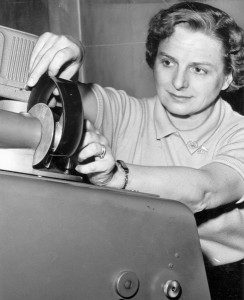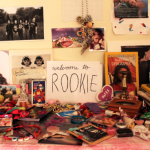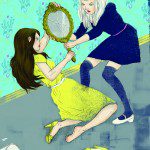Alas, poor morgue!
We knew it well. A fond look back at the old-style newspaper library.
It’s 1985, and you’re writing an article about the one-year anniversary of Marc Garneau‘s first trip into space. You start your research by talking to a librarian in the morgue, who assures you that Garneau has his own file in the biography section. He is also included in the space-flight subject file, and there are three files of pictures devoted to him in case you need some visuals.
Armed with this knowledge, you head to the six-foot-high Lektreiver, a kind of mechanized file cabinet. You flip a switch on the side to turn it on, then check the handwritten list next to the number pad to see which code corresponds with the Gs: 08. You punch the numbers in, and the machine starts to clunk and turn. The shelves appear from the top of the machine and drop down out of sight, stopping once the correct shelf is at waist level.
You pull out the two-foot-long drawer marked “GAR” and flip through the 100 or more files until you spy “Garneau, Marc.” To make sure it’s the right file, you pull out the clips from the mustard-yellow envelope and give them a once-over, careful to keep the clippings in chronological order. You need the whole file, and luckily your newspaper’s library allows you to sign out. So you put all the clips in an envelope and leave the original file, now empty, at the front with a librarian.
At your desk, you check each article carefully. As you move from the July 1984 stories about Garneau’s training and get closer to October, the headlines get bigger and the articles get longer. Finally, your eyes rest on page A1 from October 4, 1984, which bears the five-column-wide headline you need: “First Canadian in Space: For Our First Shuttle Crewman, ‘It’s Just a Job,’ Dad Says.”
Back in the morgue, several women sit elbow to elbow at a wooden desk, diligently clipping articles from the newspapers spread before them. Each page has been carefully marked up by the head librarian, who has circled key words in red pen—a full-time task. “It physically took one person a day to do the marking-up,” remembers former Globe and Mail head librarian Amanda Valpy, who started at the paper in 1968. Every article was clipped from several copies of the day’s paper with scissors or even, at the Globe, using a slat from a venetian blind and a wooden dowel. “They could do six pages at a time,” Valpy says in the soft-spoken manner of someone who spent 35 years in a library. The clips will be sorted alphabetically, then these librarians, or maybe the overnight shift, will spend an hour or more filing them. At big papers, the morgue operates until 2 a.m., or sometimes even 24 hours a day, and can have more than a dozen staff.
The walls are lined with shelves holding dictionaries and encyclopedias, plus stacks of newspapers and files full of journals and magazines. The great, revolving Lektriever sits on the other side of the room, its hundreds of skinny drawers jam-packed with files of old newspaper articles and microfiche, while tall metal filing drawers hold rolls of microfilm, likely dating to the very first issue of the paper.
Reporters stream in and out of the morgue, many racing to do some research before heading to their assignments. Some stop to ask questions, inquire about a certain clip file, or sign a file out. Some head straight to the bookshelves. Outside the library, the newsroom hums. Reporters speak quickly, phones ring shrilly, typewriters clack noisily. But inside the morgue, the noises are muffled. It is a separate peace, where the sound dims and the research begins.
The morgue is both the first stop and the final resting place for every story in the paper.
•••
“You couldn’t really tackle anything without the background,” Don Obe recalls. “And that’s what the morgue was. It was background information.” In the 1960s, he worked first at The Vancouver Sun and later the Toronto Telegram, and he always needed clips to get started on assignments. “It was the nerve centre of the whole reporting process. It was absolutely indispensable to general reporters,” he says. “The morgue was your lifeline. I don’t know how you would have prepared yourself quickly enough to carry out an assignment without that background knowledge, and that’s what it was there for.”
Like most reporters, John Saunders, former business reporter at the Toronto Star, always checked the clips first. “I can recall many times being sent out on a story and running back to the library, grabbing the clips to take a quick look to at least have some idea what I was facing,” Saunders says. “It might just be a matter of those few minutes in the library before you ran downstairs to grab a cab to go to wherever you were supposed to go.”
“Looking back at it now, it’s like the Stone Age,” says Don Gibb, from 1968 to ’88 a reporter and later city editor at the London Free Press. “But it worked! It worked at the time because you didn’t know any different.”
It certainly worked for Kirk Makin, now Globe justice reporter, who started at the paper in 1979. In an email, he calls the old morgue his “lifeblood”: “I’m sure there were very few days when I didn’t use it. It was the only way to see what had been written before on a topic. Often, I would sit at the table in there and hand write information from the articles I was examining. It was a capital offence to remove the envelopes or articles from the library, so the only other alternative was to use the photocopier. But since it was often in disrepair or there was a lineup of people waiting for it, handwritten notes were often the best alternative.”
That alternative didn’t exist at papers where reporters were allowed to take files out of the morgue, then didn’t return them. “Our desks were total shambles, and everything was a mess. You’d grab a file and forget to take it back,” confesses Gibb. Tracking down the missing files was a challenge. “We couldn’t send an email to see who in the newsroom has this clipping file,” says Joanne Madden, who was a librarian at the Star for 30 years. Instead, morgue staff sent out a note or called the newsroom desk by desk.
Keeping files in order was a further chore. “One librarian would spend hours putting clipping files in date order. And it really took hours!” says Madden. Saunders recalls how “every once in a while you would find yourself cursing an unknown colleague who had put them all back in a jumble. There was hardly anything you could do except sit down, go through them, and put them in a stack in date order.”
Obe remembers another difficulty: “You relied on that file. If a reporter had spelled a name wrong, you would go on that spelling and it would perpetuate the error.”
Despite these drawbacks, some veteran journalists become nostalgic remembering the old system. Makin is one. “Sometimes, I’d open one clip file that had clearly not been opened in years,” he says. “This was a particular pleasure. It was like opening a vault; an ancient pyramid; Al Capone’s safe!” Louise Brown, now education reporter at the Star, started there in 1976, and she used clipping files frequently. She recalls the physical sensation: “They were so soft because they were so well handled. Everything was very well worn because everybody was using them. They were soft and inky and a little bit musky.”
“I like clippings because I like to touch things,” says Catherine Dunphy, who worked at the Starfor 25 years. “I’m very old fashioned. I like paper.” There was another benefit to clips besides the tactile experience, according to Brown: “When you unfold a huge, screaming front-page story, you physically see the layout of it, you see the size of the headline. Having the physical paper clipping, you could see how big a deal it was just by the size of the headline. And it was right there in your hand.” John Honderich, chair of the Torstar board and former publisher of the Star, also likes the physical aspect of clippings. “I love seeing it on the original paper and how it actually appeared,” he says. Today, every story looks the same in a digital database. As Brown says, “The end of the world is the same as today’s recipe.”
There’s no such lingering affection for the microfiche records morgues also hold. Starting roughly in the 1950s, once a file was too big or its contents too fragile, the clips would be pasted onto a black board. “They started to get old and yellow and rotting because we had clippings from the 1920s,” explains Madden. The boards were filmed, and the film sheets would take the clippings’ place in the file. Eight boards fit on one microfiche sheet—Makin describes the result as a “giant crossword puzzle-like format.” Using a microfiche reader—a device like a sort of View-Master—is extremely hard on the eyes, and if the reader couldn’t print, reporters would have to painstakingly take notes. Not surprisingly, librarians often heard complaints about the format. “I would try explaining that we’re doing this to preserve them. But that didn’t matter to the reporters,” says Madden.
Makin remembers, “I hated them because, while they were somewhat faster to deal with, they were impersonal and lacked the textured beauty of a simple, yellowed newspaper clipping.”
•••
There are no clippings anymore at The Vancouver Sun and The Province. By 1997, the papers had transferred all of their clips to microfiche. The Globe’s three Lektrievers still harbour roughly 230,400 clip files dating from 1936 to 1985, although their fate is unclear. Celia Donnelly, the head librarian and one of eight morgue staff, says, “I have to make a good case if we want to keep the old clips when the Globe moves in a few years.”
A visit to the library in early November revealed three-quarters-empty bookshelves and two huge recycling bins. Old maps, encyclopedias, parliamentary handbooks, and back issues of magazines were on their way to the dump. There was no traffic during the hour that I was there. “Most of these periodicals are online, and the newsroom, all the reporters, have access to them at their desks,” Donnelly says.
An important role remains for librarians, though. Astrid Lange, supervisor of the library and research services department at the Star, points out that reporters don’t have time to do complicated background searches. “They’re busy doing other things. They’re on the street, or they’re calling people to talk to, or they’re at scenes reporting,” she says. Donnelly succinctly describes the role of the newspaper librarian today: “We tend to guide reporters and we help with more complicated research.” She has a rule of thumb: “If you haven’t found it in 10 minutes, then call us. Because we can find something in two minutes that’s going to take a reporter a half-hour, just because we know the resources so well.” As the Star’s Louise Brown says, “It doesn’t take a rocket scientist to pull out the Who’s Who. But there’s an art to retrieving information from the past.” Nowadays, if she has problems with a complicated online search, she’ll stop by the library on her way to the cafeteria. “They’re always magicians.”
A librarian can often conjure a single detail from a sea of information with a few clicks of her mouse. Still, Makin fondly recalls an earlier time: “I never felt emotionally and viscerally closer to my trade than I did when I could see and smell the newsprint as I leafed through those envelopes.”
Illustration by Gérard DuBois. Photographs by Tibor Kolley, The Globe and Mail.
by Martha Beach
This is a joint byline for the Ryerson Review of Journalism. All content is produced by students in their final year of the graduate or undergraduate program at the Ryerson School of Journalism.












































